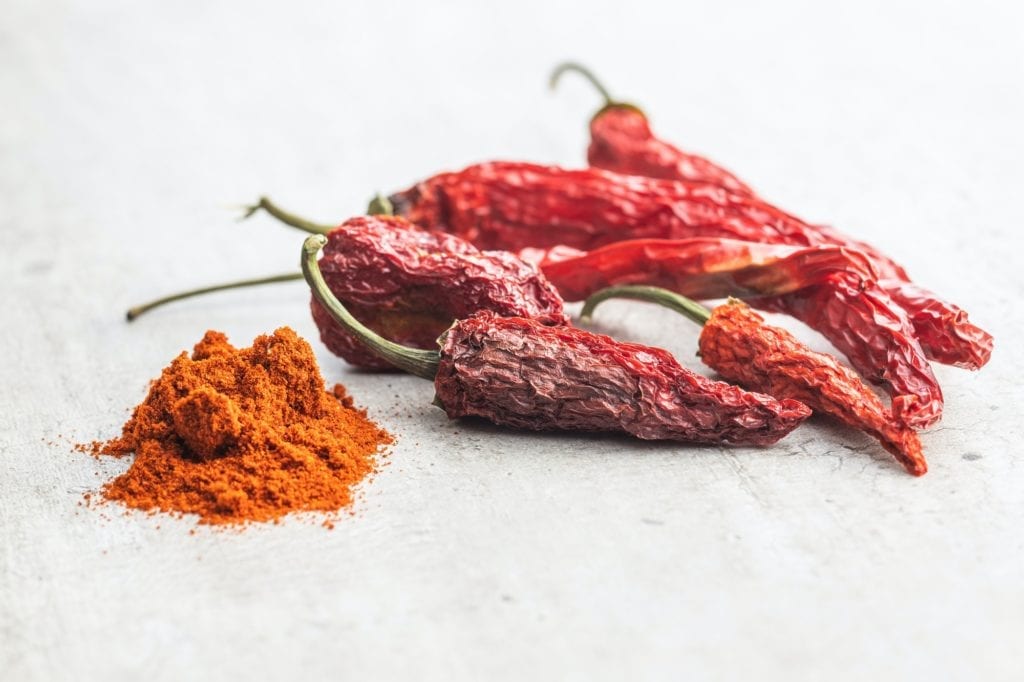
Red chilli peppers are popular as a cooking ingredient and give a hot flavour to dishes. However, they also have several applications for health and wellbeing.
The heat of your curry is generally determined by the amount and type of chilli peppers used in the recipe.
There are many types of red chillies, all of which produce a different intensity of heat. Red chillies are generally hotter and sweeter than green chillies.
Background
Chilli peppers are classified as Capsicum which are members of the nightshade family.
Their intensity comes from the compound capsaicin found in the pepper and is a neurotransmitter (a chemical that sends messages to the nervous system) and capsaicinoids (a metabolism enhancer that is responsible for the heat associated with eating chilli peppers).
Chilli peppers originated in Mexico. Following the travels of Christopher Columbus, and the introduction of the new fruits and plants he found, they began to be used across the globe, both in food and traditional medicine from the fourteenth century.
Types of red chilli
The differing heat producing qualities of each type of red chilli is determined by the variety of the pepper and by the conditions it is grown in. There are hundreds of varieties.
The strength or heat of each type of pepper is measured in Scoville heat units. The higher the Scoville score the hotter the pepper.
Scoville scores range between zero for red bell peppers through to cayenne peppers at mid-range, and on to scotch bonnet and bird’s eye peppers at the top end of the scale.
Using red chillies in curry
Fresh red chillies are best used for cooking by finely dicing them and adding to the dish to increase the level of heat. They do not tend to alter the taste of the recipe.
The heat of red chillies comes mainly from the seeds, so removing the seeds before putting the chili into a dish will give less heat.
Crushed red chilli is commonly used and is generally made up of a variety of dried red chillies. The amount to be used should be decided by your personal tolerance or preference. So, unless you are following a set recipe, is best added in small amounts and then tasted until you reach your desired heat.
An effective solution to kill discomfort caused by too much heat is to drink small sips of milk, eat ice cream or cottage cheese. Alternatively, bread or other starchy food can also help.
Medicinal uses
Red chilli peppers are high in vitamin C (containing three times the amount found in oranges), and are high in vitamins A, B and E.
It is sometimes used as a migraine treatment in a spray applied nasally, with studies showing seven out of ten migraine sufferers found total relief from their episode.
Another study showed that people who eat at least one whole or dried red chilli a month for twenty years lowered their chance of death by thirteen percent. Researchers believe this is due to the plant’s ability to counter inflammation and obesity.
Inhaling fumes from red chillies has stopped nonallergic rhinitis (a runny nose that is not caused by a cold or allergies) for up to a period of months. However, inhaling red chilli fumes may irritate pre-existing asthma.
Red chillies have also been used in traditional medicine for centuries as a means of controlling chronic pain.
Topical creams and lotions containing Capsaicin has been found to assist with the management of pain from arthritis and fibromyalgia, when used in conjunction with traditional oral pain medication.
Hot peppers are natural antimicrobials and can kill germs.

